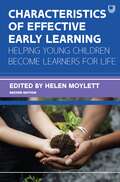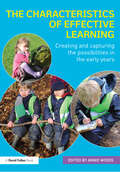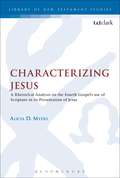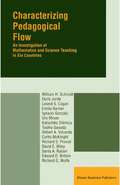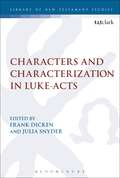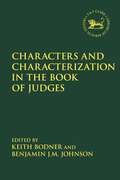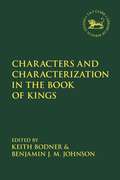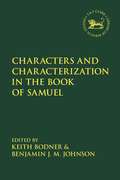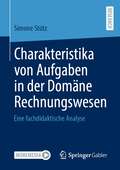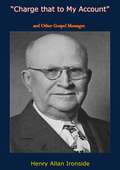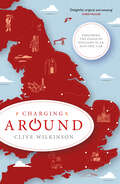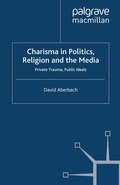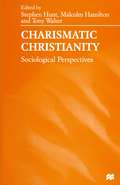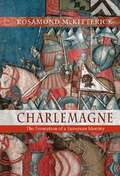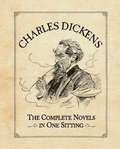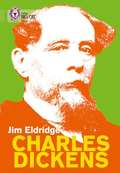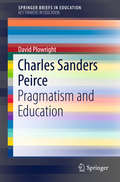- Table View
- List View
Characteristics of Effective Early Learning 2e
by Helen MoylettThis new and updated edition of Characteristics of Effective Early Learning focuses on how children learn which is just as important as what they learn. The book helps practitioners understand their key role in supporting children’s self-regulation skills and learning power through playing and exploring, active learning and thinking creatively and critically. It includes new chapters on affirmative parenting practices and the crucial role of adult communication partners in supporting children’s learning. The book:• Explains how emotional and cognitive self-regulation in the early years underpins lifelong learning• Investigates how children engage in learning through playing and exploring and are motivated through active learning• Explores how children become creative and critical thinkers, excited by their own learning power and able to review their own learning and thinking• Outlines how to approach observation, assessment and planning appropriately• Suggests how to continue the characteristics of effective learning into work with older children and staff teamsWritten by leaders in the field, based on research and rich in practical examples and case studies, this is an essential read for early years students and practitioners. The book will support those who want to find out more about how to encourage children in becoming self-regulated, playful, active learners who think deeply and creatively about their own learning and the world around them. “Whatever kind of early years setting you work in, this book is sure to inform, inspire and enthuse you and your staff.”Sue Cowley, Early Years Teacher, Author, Presenter and Trainer“The publication provides academic evidence, practical guidance and support for undergraduates and the general reader.”Michael Freeston, Director of Quality Improvement, Early Years Alliance“Such a wonderful range of chapter contributors ensures that this book remains essential reading for students and professionals at all levels.”Dr Karen Boardman, Head of Early Years Education, Edge Hill University, UKHelen Moylett is an independent early years consultant and writer. She has been an early years teacher, a local authority adviser and a university lecturer as well as head of a nursery school and children’s centre. Helen was centrally involved in developing the Early Years Foundation Stage and has received a Nursery World Lifetime Achievement Award.
The Characteristics of Effective Learning: Creating and capturing the possibilities in the early years
by Annie WoodsThe characteristics of effective learning – playing and exploring, active learning and creating and thinking critically – underpin young children’s learning and development and are central to the revised Early Years Foundation Stage. Practitioners need to be confident of planning, observing and assessing characteristics of effective learners and understand how they support children’s learning and development. The book explores what the characteristics of effective learning look like and how practitioners can create opportunities for children to express them. It considers the ways in which they connect with children’s natural explorations, play, enjoyement and the environments created by adults. Throughout the focus is on building on children’s own interests as practitioners plan for, observe and assess playing and exploring, active learning and creativity and critical thinking. Including encounters from authentic settings and provocative questions for reflective practice, the book covers: children’s well-being and motivations creating effective learning possibilities for all children engaging children’s interests the role of the adult and environment sustained shared thinking This timely new text aims to help practitioners and students develop their understanding of the charactersitics of effective learning and show them how they can support young children in become effective and motivated learners.
The Characteristics of Effective Learning: Creating and capturing the possibilities in the early years
by Annie WoodsThe characteristics of effective learning – playing and exploring, active learning and creating and thinking critically – underpin young children’s learning and development and are central to the revised Early Years Foundation Stage. Practitioners need to be confident of planning, observing and assessing characteristics of effective learners and understand how they support children’s learning and development. The book explores what the characteristics of effective learning look like and how practitioners can create opportunities for children to express them. It considers the ways in which they connect with children’s natural explorations, play, enjoyement and the environments created by adults. Throughout the focus is on building on children’s own interests as practitioners plan for, observe and assess playing and exploring, active learning and creativity and critical thinking. Including encounters from authentic settings and provocative questions for reflective practice, the book covers: children’s well-being and motivations creating effective learning possibilities for all children engaging children’s interests the role of the adult and environment sustained shared thinking This timely new text aims to help practitioners and students develop their understanding of the charactersitics of effective learning and show them how they can support young children in become effective and motivated learners.
Characterizing Jesus: A Rhetorical Analysis on the Fourth Gospel's Use of Scripture in its Presentation of Jesus (The Library of New Testament Studies #458)
by Alicia D MyersThis study explores how the Fourth Gospel's use of Scripture contributes to its characterization of Jesus. Utilizing literary-rhetorical criticism, Myers approaches the Gospel in its final form, paying particular attention to how Greco-Roman rhetoric can assist in understanding the ways in which Scripture is employed to support the presentation of Jesus. It offers further evidence in favour of the Gospel's use of rhetoric (particularly the practices of synkrisis, ekpharsis, and prosopopoiia), and gives scholars a new way to use rhetoric to better understand the use of Scripture in the Fourth Gospel and the New Testament as a whole.The book proceeds in three parts. First, it examines ancient Mediterranean practices of narration and characterization in relationship to the Gospel, concluding with an analysis of the Johannine prologue. In the second and third parts, it investigates explicit appeals to Scripture that aremade both in and outside of Jesus' discourses. Through these analyses, Myers contends that the pervasive presence of Scripture in quotations, allusions, and references acts as corroborating evidence supporting the evangelist's presentation of Jesus.
Characterizing Pedagogical Flow: An Investigation of Mathematics and Science Teaching in Six Countries
by W. H. SchmidtCharacterizing Pedagogical Flow presents conclusions from a multi-disciplinary, multi-national research project blending quantitative and qualitative approaches through a discourse methodology. The work produced portraits of mathematics and science education that were dramatically different for each of the countries involved: France, Japan, Norway, Spain, Switzerland, and the United States. To explain these differences, it is proposed that the interaction of curriculum and pedagogy is culturally unique and yields classroom learning experiences that are qualitatively different from country to country. This idea has profound implications for how international education research is interpreted.
Characters and Characterization in Luke-Acts (The Library of New Testament Studies)
by Dr Frank Dicken Dr Julia SnyderLike all skilful authors, the composer of the biblical books of Luke and Acts understood that a good story requires more than a gripping plot - a persuasive narrative also needs well-portrayed, plot-enhancing characters. This book brings together a set of new essays examining characters and characterization in those books from a variety of methodological perspectives. The essays illustrate how narratological, sociolinguistic, reader-response, feminist, redaction, reception historical, and comparative literature approaches can be fruitfully applied to the question of Luke's techniques of characterization. Theoretical and methodological discussions are complemented with case studies of specific Lukan characters. Together, the essays reflect the understanding that while many of the literary techniques involved in characterization attest a certain universality, each writer also brings his or her own unique perspective and talent to the portrayal and use of characters, with the result that analysis of a writer's characters and style of characterization can enhance appreciation of that writer's work.
Characters and Characterization in Luke-Acts (The Library of New Testament Studies #548)
by Frank Dicken Julia SnyderLike all skilful authors, the composer of the biblical books of Luke and Acts understood that a good story requires more than a gripping plot - a persuasive narrative also needs well-portrayed, plot-enhancing characters. This book brings together a set of new essays examining characters and characterization in those books from a variety of methodological perspectives. The essays illustrate how narratological, sociolinguistic, reader-response, feminist, redaction, reception historical, and comparative literature approaches can be fruitfully applied to the question of Luke's techniques of characterization. Theoretical and methodological discussions are complemented with case studies of specific Lukan characters. Together, the essays reflect the understanding that while many of the literary techniques involved in characterization attest a certain universality, each writer also brings his or her own unique perspective and talent to the portrayal and use of characters, with the result that analysis of a writer's characters and style of characterization can enhance appreciation of that writer's work.
Characters and Characterization in the Book of Judges (The Library of Hebrew Bible/Old Testament Studies)
In the Book of Judges, why, if we view Samson as a heroic Übermensch, do we read his story one way, yet if we read him as a buffoonish and violent oaf, we read the story another way? How does our assessment of the characters of a story, our empathy with them or suspicion of them, shape the way we read it?This book addresses these questions by analyzing the complex characterization in the Book of Judges, paying attention to an often neglected but important area of study in the Hebrew Bible. Its international group of contributors explore the implications of characterization on storytelling, situating their contributions within the context of literary studies of the Hebrew Bible, and offering multiple perspectives on the many and various characters one encounters in the Book of Judges.Chapters examine a range of topics, including the relationship between humor, characterization and theology in Judges; the intersection of characterization and ethics through the story of the story of Jephthah's daughter; why the 'trickster hero' Ehud disturbs interpreters; and the ways in which Abimelech's characterization affects the key narrative themes of succession and kingship in his story.
Characters and Characterization in the Book of Kings (The Library of Hebrew Bible/Old Testament Studies)
by Keith Bodner Benjamin J. M. JohnsonThis book is an examination of characters in the books of Kings; showing how understanding and interpretation of key characters affects readings of the story. The volume begins with more general pieces addressing how the study of characters can shed light on the composition history of Kings and on how characters and characterization can be considered with respect to ethics, particularly with respect to the moral complexity of biblical characters.Contributors then consider key characters within the Kings narrative in depth, such as Nathan, Bathsheba, Solomon and Jezebel. The contributors use their own specific expertise to analyze these characters and more, drawing on insights from literary theory and considering such approaches as questioning our view of a particular character with based on the character within the text with whom we identify. Contributors also assess whether or not characters as portrayed in the biblical text necessarily match up to their possible counterparts in history.
Characters and Characterization in the Book of Samuel (The Library of Hebrew Bible/Old Testament Studies)
by Keith Bodner Benjamin J. M. JohnsonCharacters provide the entry point to the story of the books of Samuel, just as they do in all stories. In this book the history of research into characters in Samuel, and the role(s) they play in the text are examined and discussed. The contributors look at the interpretative function of characters in the Samuel stories, and at issues of textual composition and what profiling of characters within the text can add to theories surrounding this issue. Specific characters are also profiled and studied. The character of God is examined: is God kind towards Israel? Is God loving and 'worthy to be praised' 2 Sam 22.4. Characters such as Hannah are examined from the perspective of literary type, as well as Eli as priest and Samuel himself as prophet. All of the major characters within the books are studied, including David and Jonathan, and chapters also treat the minor characters and offer information on their roles in the structure of the text. The contributors provide a range of different approaches to characterization, according to their specific expertise, and provide a thorough handbook to the characters in Samuel and their roles in the literary make-up of the text.
The Characters of Elijah and Elisha and the Deuteronomic Evaluation of Prophecy: Miracles and Manipulation (The Library of Hebrew Bible/Old Testament Studies)
by Roy L. HellerRoy L. Heller looks at the prophets Elijah and Elisha in the books of Kings charting a two-fold characterization that portrays these prophetic figures in both positive and negative lights. In the narratives of Kings Elijah and Elisha often parallel other prophetic figures from Israel's history: they perform miraculous signs, they speak in the name of God, and they pronounce judgments upon the nation of Israel for its idolatrous worship. There are, however, other stories which have troubled readers and scholars alike: Elijah's cowardly running from the threats of Jezebel, his self-pitying complaint to God that he was the only true Israelite left, and Elisha's cursing a group of little boys who, in turn, are slaughtered by two female bears. Scholars have traditionally ignored or belittled the negative stories of the prophets, seeing them as either late additions to the biblical text or as minor, unimportant stories that can easily be dismissed. Heller, however, argues that the dual characterization of Elijah and Elisha reflects an ambivalent attitude that the narrator of Kings has toward prophecy as a whole, an attitude that is reflected in the book of Deuteronomy itself. This forces readers of the biblical text to pose the question; “how may Israel best know and follow God?” The stories of Elijah and Elisha make the answer clear: the words and lives of the prophets are a possible way for God to reveal how Israel is to live, but those words and lives must always be considered with a degree of suspicion and must always be evaluated in light of the clear and straightforward teaching of Deuteronomy.
Charakteristika von Aufgaben in der Domäne Rechnungswesen: Eine fachdidaktische Analyse
by Simone StützDas vorliegende Buch beschäftigt sich mit den Charakteristika von Aufgaben in der Domäne Rechnungswesen aus einer fachdidaktischen Perspektive. Dazu wurde der aktuelle fachdidaktische Diskussionsstand aus der Fachdidaktik Rechnungswesen aufgearbeitet und auf Basis dessen ein umfassendes Kategoriensystem zur Analyse und Bewertung von Aufgaben aus dem Rechnungswesen entwickelt. Das Kategoriensystem kann des Weiteren genutzt werden, um neue Aufgaben für das Rechnungswesen zu entwickeln und bestehende Aufgaben zu optimieren. Darüber hinaus wurden 2.000 Rechnungswesenaufgaben aus 15 verschiedenen Schulbüchern von drei österreichischen Verlagen mithilfe des Kategoriensystems analysiert und bewertet. Damit kann der Wissensstand zu den Charakteristika von Aufgaben in der Domäne Rechnungswesen erheblich erweitert werden. Die Ergebnisse der umfassenden Auswertungen zeigen, dass bei den Aufgaben Verbesserungspotenzial besteht und die im Rahmen des Kategoriensystems formulierten Ansprüche an Aufgaben im Rechnungswesen derzeit nicht umfassend erfüllt werden. Darüber hinaus wird festgestellt, dass im derzeitigen Rechnungswesenunterricht sowohl eine Änderung der Aufgabenkultur als auch curriculare Änderungen und Weiterentwicklungen notwendig sind.
“Charge that to My Account” and Other Gospel Messages
by Henry IronsideBecause GOD has been pleased to set His seal of approval upon these simple gospel messages by using them in the awakening and salvation of sinners, they can be found here, in book form, in the earnest hope that many who read them may find joy and peace in believing!First published in 1931, Pastor H. A. Ironside’s “Charge that to My Account” and Other Gospel Messages contains 12 interesting studies, beginning with his best known gospel presentation based on Paul’s letter to Philemon, and includes “Will a Loving God Permit Anyone to Be Eternally Lost?” and “Inside the Veil, Outside the Camp.”
The Charged Classroom: Predicaments and Possibilities for Democratic Teaching
by Judith L. PaceAt a time when debate over school reform commands unprecedented attention, Judith L. Pace argues we must grapple with the underlying challenges of classroom teaching and, at the same time, strive to realize the ideals of democratic education. Building on three qualitative studies in grades four through twelve, The Charged Classroom examines the deeply embedded tensions, escalating pressures, and exciting possibilities of the contemporary American public school classroom. Through detailed descriptions and analyses of social studies and English language arts classrooms, Pace disentangles how teachers and students navigate three charged arenas: academic expectations, discussion of provocative topics, and curricular demands. In each domain, democratic learning opportunities, such as promotion of positive student identity, dialogue across differences, and exploration of conflict, are both opened up and closed down. A passionate and persuasive call for education reform, the book offers crucial insights about the realities of teaching and key recommendations for advancing democratic education in a multicultural society.
The Charged Classroom: Predicaments and Possibilities for Democratic Teaching
by Judith L. PaceAt a time when debate over school reform commands unprecedented attention, Judith L. Pace argues we must grapple with the underlying challenges of classroom teaching and, at the same time, strive to realize the ideals of democratic education. Building on three qualitative studies in grades four through twelve, The Charged Classroom examines the deeply embedded tensions, escalating pressures, and exciting possibilities of the contemporary American public school classroom. Through detailed descriptions and analyses of social studies and English language arts classrooms, Pace disentangles how teachers and students navigate three charged arenas: academic expectations, discussion of provocative topics, and curricular demands. In each domain, democratic learning opportunities, such as promotion of positive student identity, dialogue across differences, and exploration of conflict, are both opened up and closed down. A passionate and persuasive call for education reform, the book offers crucial insights about the realities of teaching and key recommendations for advancing democratic education in a multicultural society.
Charging Around: Exploring the Edges of England by Electric Car
by Clive Wilkinson‘A delightful, original, amusing tour of some of the UK’s less explored places’ – Chris MullinHaving crossed a continent by train and sailed around the world by container ship, Clive Wilkinson has always had a penchant for slow travel. As his eightieth birthday approaches, he and his wife Joan set out on a new expedition: to tour the edges of England by electric car. How hard could that be?Given the parlous state of the country’s charge-point infrastructure back in 2018, the answer turns out to be ‘very’. In a 1,900-mile odyssey through fading seaside towns, rainswept hilltop passes and England’s only desert, each day’s driving for these unlikely pioneers is overshadowed by a cloud of apprehension. Will they make it to the next charge point? Will it be in working order? Will someone else be using it?You could only undertake such a trip with a calm temperament and robust sense of humour. Fortunately, Clive has both. With a relentless curiosity for history, geography and, above all, people, he and Joan explore the reality of life on England’s periphery – the ‘left behind’ areas that, by voting for Brexit, changed the course of British history – making new friends with every mile.
Charisma in Politics, Religion and the Media: Private Trauma, Public Ideals
by D. AberbachWhat are the origins of charisma? Are these the same in the various forms of public life, in politics and the media as well as in religion? In this new and radical interpretation of charisma, David Aberbach argues that the basis of charisma in all its forms must be found in the often-obscure symbolic intersection between the inner world of the charismatic and external social and political reality. As illustrations of various facets of this argument, he provides general analyses of charisma in politics, religion and the media as well as individual studies of Churchill, Hitler, Krishnamurti, Bialik and Chaplin.
Charismatic Christianity: Sociological Perspectives
by Stephen J. Hunt Tony Walter Malcolm HamiltonThe charismatic movement has a high profile in contemporary Christianity. The book's contributors include insiders and outsiders, charismatics and sociologists; with Britain as their focus, they trace the movement's international connections, historical development and variety. The book provides a wealth of information and analysis which will interest both those within the movement and students of religion wanting to know more about it.
Charles Dickens: The Complete Novels in One Sitting (RP Minis)
by Joelle HerrCelebrate the bicentennial birthday of Charles Dickens with this Miniature Edition packed with witty summaries of the novels of one of history's most beloved storytellers. All fans of great literature can enjoy these perfectly portable renditions of Oliver Twist, A Christmas Carol, Great Expectations, A Tale of Two Cities, and all the Dickensian classics. Featuring synopses, character profiles, and illustrations, this mini book brings to life twenty classic tales and the iconic characters that populate the world of Dickens.
Charles Dickens: The Complete Novels in One Sitting (RP Minis)
by Joelle HerrCelebrate the bicentennial birthday of Charles Dickens with this Miniature Edition packed with witty summaries of the novels of one of history's most beloved storytellers. All fans of great literature can enjoy these perfectly portable renditions of Oliver Twist, A Christmas Carol, Great Expectations, A Tale of Two Cities, and all the Dickensian classics. Featuring synopses, character profiles, and illustrations, this mini book brings to life twenty classic tales and the iconic characters that populate the world of Dickens.
Charles Dickens: Band 11/Lime (Collins Big Cat)
by Jim Eldridge Mark Oldroyd Collins Big CatCharles Dickens was a famous writer who lived in the 19th century. Discover what life was like for Charles, from spending his childhood working in a factory to finding a job as a law clerk and starting his writing career in this biography by Jim Eldridge.
Charles Sanders Peirce: Pragmatism and Education (SpringerBriefs in Education)
by David PlowrightThis book introduces a number of selected ideas from the work of Charles Sanders Peirce, the founder of pragmatism. Peirce, pronounced ‘purse’, was born in America in 1839 and died in 1914. He published little in his own lifetime and he continually struggled to become recognised as a respected author with ideas that were highly creative, original and unique. The book begins with an examination of Peirce’s life history. This is followed by an explanation of pragmatism, which states that an understanding of a concept can only be fully grasped by knowing what its practical effects are. The author then explains a number of Peirce’s ideas that are based on his pragmatic maxim: · scientific inquiry as a method of investigation and its relevance to everyday thinking· inferential thinking based on abduction, deduction and induction and its use in educational research· semiotics, the study of signs and its relevance to the development of conceptual understanding· his profound and insightful ontological categories of Firstness, Secondness and Thirdness and their application to developing an understanding of the world around usThis introductory text is written in a clear and accessible style. Numerous examples are used throughout the book to illustrate Peirce’s complex and sophisticated ideas and to show how his thinking can be applied to education.
The Charleston Orphan House: Children's Lives in the First Public Orphanage in America (Markets and Governments in Economic History)
by John E. MurrayThe first public orphanage in America, the Charleston Orphan House saw to the welfare and education of thousands of children from poor white families in the urban South. From wealthy benefactors to the families who sought its assistance to the artisans and merchants who relied on its charges as apprentices, the Orphan House was a critical component of the city’s social fabric. By bringing together white citizens from all levels of society, it also played a powerful political role in maintaining the prevailing social order. John E. Murray tells the story of the Charleston Orphan House for the first time through the words of those who lived there or had family members who did. Through their letters and petitions, the book follows the families from the events and decisions that led them to the Charleston Orphan House through the children’s time spent there to, in a few cases, their later adult lives. What these accounts reveal are families struggling to maintain ties after catastrophic loss and to preserve bonds with children who no longer lived under their roofs. An intimate glimpse into the lives of the white poor in early American history, The Charleston Orphan House is moreover an illuminating look at social welfare provision in the antebellum South.
The Charleston Orphan House: Children's Lives in the First Public Orphanage in America (Markets and Governments in Economic History)
by John E. MurrayThe first public orphanage in America, the Charleston Orphan House saw to the welfare and education of thousands of children from poor white families in the urban South. From wealthy benefactors to the families who sought its assistance to the artisans and merchants who relied on its charges as apprentices, the Orphan House was a critical component of the city’s social fabric. By bringing together white citizens from all levels of society, it also played a powerful political role in maintaining the prevailing social order. John E. Murray tells the story of the Charleston Orphan House for the first time through the words of those who lived there or had family members who did. Through their letters and petitions, the book follows the families from the events and decisions that led them to the Charleston Orphan House through the children’s time spent there to, in a few cases, their later adult lives. What these accounts reveal are families struggling to maintain ties after catastrophic loss and to preserve bonds with children who no longer lived under their roofs. An intimate glimpse into the lives of the white poor in early American history, The Charleston Orphan House is moreover an illuminating look at social welfare provision in the antebellum South.
